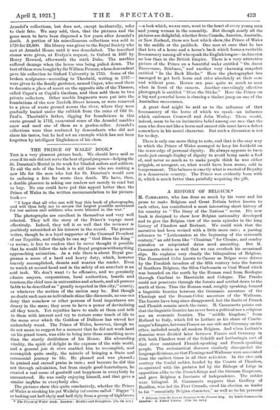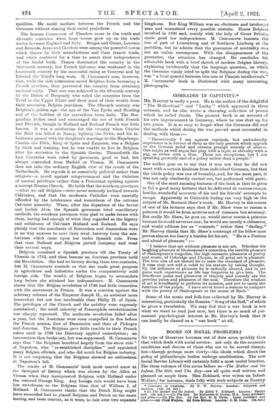A HISTORY OF BELGIUM.*
M. CAMHAERTS, who has done so much by his verse and his prose to make Belgium and Great Britain better known to each other, has contributed a most interesting short history of his country to " The Story of the Nations " series. His new book is designed to show how Belgian nationality developed and to give the Belgian view of the main episodes in the long history of Flanders and Brabant. We could wish that the narrative had been revised with a little more care ; a passing reference to " Lutheranism at the beginning of the sixteenth century," an odd form like " Clunisian " for Cluniac, and sundry mistaken or misprinted dates need amending. But M. Cammaerts writes so well that we can overlook his occasional slips. He explains very clearly the bilingualism of Belgium. The Romanized Celts known to Caesar as Belgae were driven by the Frankish invaders of the fifth century into the forests of Southern Belgium, the Silva Carbonaria or Coal Wood which was bounded on the north by the Roman road from Boulogne through Cambrai to Maestricht and Cologne. The Franks could not penetrate through the forests and settled down to the north of them. Thus the Roman road, roughly speaking, formed a linguistic frontier between the Germanic ancestors of the Flemings and the Roman-Celtic ancestors of the Walloons. The forests have long since disappeared, but the limits of French and Flemish remain much the same. M. Cammaerts points out that the linguistic frontier has never been a political nor a religious nor an economic frontier. The " middle kingdom," from Holland to Italy, which fell to Lothair as his share of Charle- magne's Empire, betweenFrance on one side and Germany on the other, included nearly all modern Belgium. And when Lothair's domains were divided later between France and Germany in 879, both Flanders west of the Scheldt and Lotharingia east of that river contained Flemish-speaking and French-speaking people. The ecclesiastical dioceses similarly disregarded the language divisions, so that Flemings and Walloons were associated from the earliest times in all their activities. In the eleventh century the feudal nobles, headed by the Counts of Flanders, co-operated with the prelates led by the Bishops of Liege in opposition alike to the French Kings and the German Emperors, and gave Belgium a foretaste of independence. The nobles were bilingual. M. Cammaerts suggests that Godfrey of Bouillon, who led the First Crusade, owed his election as leader to his " essentially Belgian character," as well as to his personal • Dekiwn !mm the ROM3fl Invasion to the Present Day. By Emile Camnporta. London T. Fisher Uuwia. [121. ed. net.1
qualities. He could mediate between the French and the Germans without sharing their racial prejudices.
The famous Communes of Flanders arose in the tenth and eleventh centuries, when large towns grew up on the trade routes between England and Italy. Bruges and Ghent, Louvain and Brussels, Arras and Cambrai were among the powerful towns which throve by their manufactures and their transit trade, and which contrived for a time to assert their independence of the feudal lords. France dominated the country in the thirteenth century, but French influence was weakened in the fourteenth century by the successful rising at Courtrai and by Edward the Third's long wars. M. Cammaerts sees, however, that, while the rich communes saved Belgium from becoming a French province, they prevented the country from attaining national unity. That aim was achieved in the fifteenth century by the Dukes of Burgundy who ruled the countries from the Texel to the Upper Rhine and drew most- of their wealth from their seventeen Belgian provinces. The fifteenth century was Belgium's golden age—the age of the Van Eycks and Memling and of the builders of the marvellous town, halls. The Bur- gundian Dukes used and encouraged the use of both French and Flemish, though in Holland and Zeeland French was little known. It was a misfortune for the country when Charles the Bold was killed at Nancy, fighting the Swiss, and his in- heritance passed with his daughter's marriage to the Hapsburgs.
Charles the Fifth, King of Spain and Emperor, was a Belgian by birth and training, but he was unable to live in Belgium after his accession to the Spanish throne. Thenceforth the Low Countries were ruled by governors, good or bad, but always controlled from Madrid or Vienna. M. Cammaerts does not take the ordinary English view of the revolt of the Netherlands. He regards it as essentially political rather than religious—a revolt against misgovernment and the violation of ancient privileges rather than a Protestant uprising against a corrupt Roman Church. He holds that the southern provinces —what we call Belgium—were never seriously inclined towards Calvinism, and that the moderate Catholics were mortally offended by the intolerance and iconoclasm of the extreme Calvinist minority. When, after the departure of the brutal and foolish Alva, the Spanish governors tried conciliatory methods, the southern provinces were glad to make terms with them, having had enough of what they regarded as the bigotry and selfishness of Calvinist Holland and Zeeland. He says plainly that the merchants of Rotterdam. and Amsterdam were in no way anxious to save their rival Antwerp from the mis- fortunes which came upon her under Spanish rule. From- that time Holland and Belgium parted company and went their several ways.
Belgium remained a Spanish- province till the Treaty of Utrecht in 1713, and then became an Austrian province until the Revolution. She had no history during these two centuries, but M Cammaerts reminds us that she made great progress- in agriculture and industries under the comparatively mild foreign rule, - The wealth of Belgium began to moumulate long- before she attained her independence. M. Cammaerts shows that the Belgian revolution of 1789 had little connexion
with the movement in France. It was a reaction against the arbitrary reforms of the Emperor Joseph IL, an- autocrat more benevolent but not less- intolerable than Philip II. of Spain. The privileges of the Church and- the nobility were expressly maintained ; the small minority of Francophile revolutionaries was sharply repressed. The moderate revolution failed after a year, but the Austrians were -soon compelled to flee before the French armies, first of Dumouries and then of Pichegru and Jourdan. The Belgians gave little -trouble to their -French rulers until in 1798 the Directory applied conscription ; an insurrection then broke out, but was suppressed, AL Cammaerts says that " the Belgians benefited largely from the stern rule " of Napoleon, who " re-established discipline " and appointed many Belgian officials, and who did much for Belgian industry. It is not surprising- that the Belgians showed no enthusiasm at Napoleon's fall.
The reader of M. Cammaerts' book must marvel anew at the disregard of history which was shown by the Allies at Vienna when they incorporated Belgium with Holland under the restored Orange King. Any foreign rule would have been less unwelcome to the Belgians than that of William L of Holland. M. Cammaerts thinks that the Dutch King might have succeeded had he placed Belgians and Dutch on the same footing and been content, as it were, to rule over two separate
kingdoms. But King William was an obstinate and intolerant man and committed every possible mistake. - Hence -Belgium revolted- in 1830 and, mainly with the help of Great Britain, made good her independence. M. Cammaerte laments• the loss of part of Luxemburg and of Southern Limburg at- the partition, but he admits that the guarantee of neutrality was not an unfair recompense. With the disappearance of the guarantee, the situation has changed. He • concludes his admirable book with a brief sketch of modern Belgian history, explaining incidentally that the language question, on which the Germans vainly- tried to split the Belgians during the war, was " a local quarrel between two sets of Flemish intellectuals." M. Cammaerts' book is illustrated with many interesting photographs.



































 Previous page
Previous page